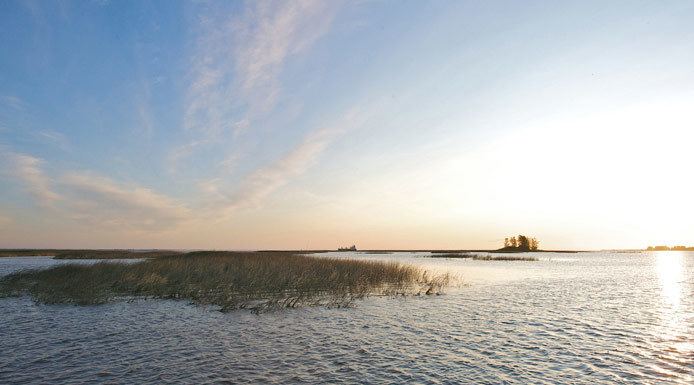Primary outflows Saint Lawrence River Max. length 32 km (20 mi) Width 10 km Mean depth 3 m | Type Natural Basin countries Canada Area 353 km² Surface elevation 3.3 m Province Québec | |
 | ||
Primary inflows | ||
Hunting duck on lake saint pierre
Lake Saint Pierre (French: Lac Saint-Pierre) is a lake in Quebec, Canada, a widening of the Saint Lawrence River between Sorel-Tracy and Trois-Rivières. It is located downstream, and northeast, of Montreal; and upstream, and southwest, of Quebec City.
Contents
- Hunting duck on lake saint pierre
- Map of Lac Saint Pierre QuC3A9bec Canada
- Geography
- Toponymy
- Natural environment
- Biosphere Reserve
- Wildlife Sanctuary of Great Island
- Nicolet Bird Sanctuary
- Environment
- In popular culture
- References
Map of Lac Saint-Pierre, Qu%C3%A9bec, Canada
This lake which is 32 kilometres (20 mi) long (excluding Sorel Islands) and 14 kilometres (8.7 mi) wide, is part of the St. Lawrence Seaway. Including its shoreline, islands, and wetlands, the lake is a nature reserve. The body of water is recognized as Ramsar site and as Biosphere Reserve, due to the presence of many marshes or wetlands that are frequented by waterfowl. Recreational activities on the river (such as fishing, boating, sailing, swimming, water skiing, nature observation) are active mainly in summer season.
Geography
The lake is located in the Regional County Municipalities of Nicolet-Yamaska, Maskinongé, D'Autray, and Pierre-De Saurel, in addition to the city of Trois-Rivières. The shores of the lake affect several municipalities:
Toponymy
The lake was named by Samuel de Champlain following its passage on 29 June 1603, the day of the Saint-Pierre. The Abenaki called Lake Nebesek, which means at lac. Jacques Cartier, during his second voyage to Canada in 1535, had given him the name of "Angoulême".
Natural environment
This seasonally-flooded area is an important stopping point for hundreds of thousands of migrating waterfowl. It is also an important nesting area for herons: more have been counted here than in any other place in North America. In 1998, it was recognized as a wetland of international significance under the Ramsar Convention.
The wildlife experts have identified 23 species of mammals around Lake Saint-Pierre, one of the most abundant species is the muskrat (Ondatra zibethicus), which is found in abundance in the lake.
Biosphere Reserve
Lake Saint-Pierre was appointed Biosphere Reserve by UNESCO in 2000. The biosphere reserve of Lac-Saint-Pierre has an area of 480 square kilometres (190 sq mi), whose 31 square kilometres (12 sq mi) in core areas and 124 square kilometres (48 sq mi) in buffer zones. The core areas are composed of Wildlife Refuge Great Island and bird refuge Nicolet.
Wildlife Sanctuary of Great Island
Wildlife Sanctuary of "Grande-Île" (Great Island) is located on Grande-île in the Archipelago of Saint-Pierre Lake. It has an area of 1.45 square metres (15.6 sq ft). This wildlife refuge was created in 1992 is the protection of one of the largest heron colonies in North America. It houses more than 5,000 herons.
Nicolet Bird Sanctuary
The "birds Nicolet refuge" is a protected area of 30 square kilometres (12 sq mi) which protects a staging area for ducks and Canada goose and also a nesting area for waterfowl. National Defence has acquired the site in the 1950. The site was recognized as a rest area in 1969 and as a refuge in 1982.
Environment
Since the years 1970s, the water quality of Lake Saint-Pierre has improved significantly, thanks to governmental requirements, such as:
The traffic on the river is a significant factor concerning shoreline erosion due to waves produced, especially by large vessels using the St. Lawrence Seaway. Channel Seaway changed the course of the natural flow of the river. In places, the flow distribution in the lake due to some stagnation of water near the banks, creating a silting.
In the area of Nicolet, the lake bottom contains an undetermined unexploded warheads from the centre of military fire which has been in operation in the 1950s to the 2000s number.
